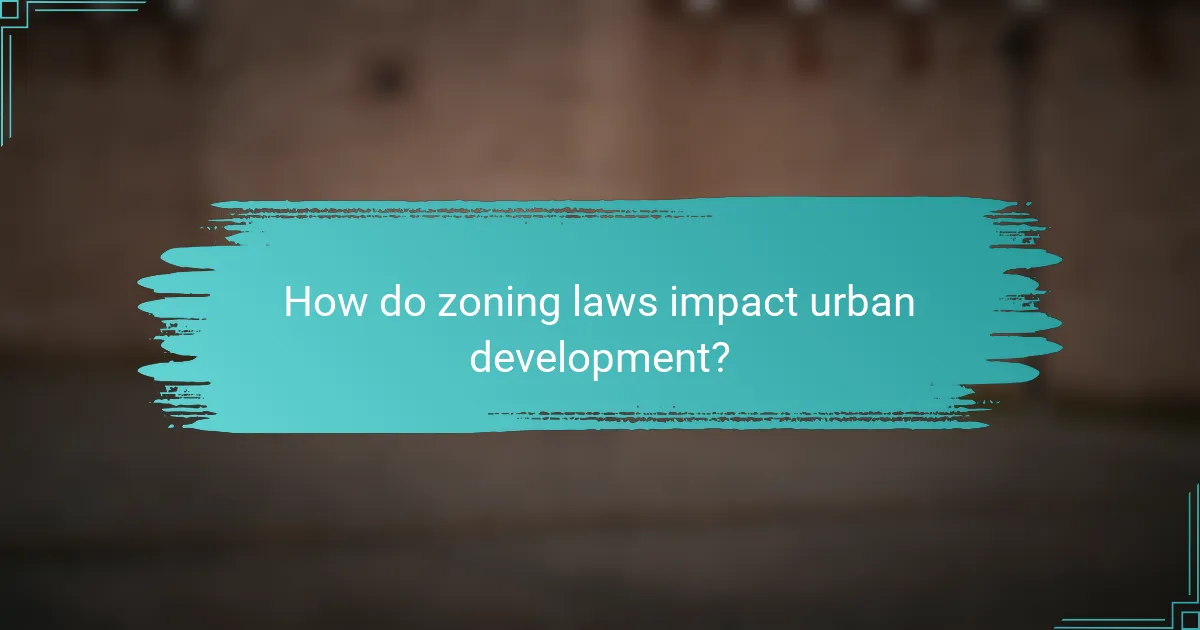Zoning laws play a crucial role in shaping urban environments by regulating land use and influencing the availability of housing and local businesses. Compliance with these laws involves obtaining permits, adhering to building codes, and conducting environmental assessments, ensuring that developments align with community standards. For businesses, understanding and navigating these regulations is essential for optimizing operations and fostering sustainable growth in urban areas.

How do zoning laws impact urban development?
Zoning laws significantly shape urban development by regulating land use, influencing housing availability, and affecting local businesses. These regulations determine how land can be utilized, which in turn impacts the overall growth and character of urban areas.
Influence on land use
Zoning laws dictate the types of activities allowed on specific parcels of land, such as residential, commercial, or industrial use. This classification can enhance urban planning by ensuring compatible land uses are located near one another, reducing conflicts and promoting efficient infrastructure development.
For example, a zoning ordinance may restrict heavy industrial operations in residential neighborhoods, thus protecting the quality of life for residents. Understanding local zoning classifications is crucial for developers and investors to identify viable opportunities.
Effects on housing availability
Zoning regulations can directly affect the availability of housing by controlling density and the types of housing that can be built. In many urban areas, restrictive zoning can lead to a shortage of affordable housing options, as developers may be limited in the number of units they can construct.
For instance, areas zoned exclusively for single-family homes may not accommodate multi-family units, which are often more affordable. Policymakers must balance zoning laws to encourage diverse housing options while maintaining community standards.
Impact on local businesses
Zoning laws can either support or hinder local businesses by determining where commercial activities can take place. Areas designated for commercial use may attract more foot traffic, benefiting retail establishments, while restrictions in other zones can limit business growth.
For example, a city may zone a district for mixed-use development, allowing shops, restaurants, and residences to coexist. This can create vibrant neighborhoods but may also lead to conflicts between businesses and residents if not managed properly.
Environmental considerations
Zoning laws play a critical role in environmental protection by regulating land development to minimize ecological impact. They can enforce green spaces, buffer zones, and sustainable practices, which are essential for maintaining urban ecosystems.
For example, zoning regulations may require developers to include parks or green roofs in new projects, contributing to urban biodiversity and improving air quality. Local governments must consider environmental implications when drafting zoning laws to promote sustainable urban growth.

What are the key zoning law compliance requirements?
Key zoning law compliance requirements include obtaining necessary permits, adhering to building codes, and conducting environmental impact assessments. These elements ensure that developments align with local regulations and community standards.
Permitting processes
The permitting process is essential for ensuring that any proposed development complies with local zoning laws. Typically, this involves submitting an application to the local zoning board or planning department, which reviews the plans against existing regulations.
Common permits include zoning permits, building permits, and special use permits. Each type may have specific requirements, such as public hearings or additional documentation, which can vary by municipality.
Building codes adherence
Building codes are regulations that set standards for construction and safety. Compliance with these codes is mandatory and involves following guidelines related to structural integrity, fire safety, and accessibility.
Local building codes often reflect national standards but may include additional requirements specific to the region. Developers should consult local authorities to ensure all aspects of their project meet these codes to avoid costly delays or fines.
Environmental impact assessments
Environmental impact assessments (EIAs) evaluate the potential effects of a proposed project on the surrounding environment. These assessments are often required for larger developments and help identify any significant negative impacts.
Conducting an EIA typically involves a detailed analysis of factors such as air and water quality, wildlife habitats, and community resources. Engaging with local environmental agencies early in the process can streamline compliance and foster community support.

How can businesses navigate zoning regulations in urban areas?
Businesses can navigate zoning regulations in urban areas by understanding the specific laws that apply to their location and industry. This involves consulting experts, utilizing zoning maps, and engaging with local government to ensure compliance and optimize their operations.
Consulting with zoning experts
Engaging zoning experts can provide businesses with tailored advice on local regulations and compliance requirements. These professionals often have extensive knowledge of zoning laws and can help identify potential challenges and opportunities specific to a business’s location.
When selecting a zoning expert, consider their experience with similar businesses or industries. This can lead to more relevant insights and strategies that align with your operational goals.
Utilizing zoning maps
Zoning maps are essential tools for businesses to understand the land use designations in their area. These maps indicate what types of activities are permitted in specific zones, helping businesses determine if their intended use aligns with local regulations.
Regularly reviewing zoning maps can also alert businesses to any changes in zoning laws that could affect their operations. Many municipalities provide online access to these maps, making it easier to stay informed.
Engaging with local government
Building a relationship with local government officials can facilitate smoother navigation of zoning regulations. Attending public meetings and participating in community discussions can provide valuable insights into upcoming zoning changes and development plans.
Additionally, local government offices often offer resources and guidance for businesses seeking to understand compliance requirements. Establishing open lines of communication can help address any concerns before they escalate into compliance issues.

What are the common zoning classifications?
Zoning classifications categorize land use to ensure orderly development and community welfare. Common classifications include residential, commercial, and industrial, each with distinct regulations and purposes.
Residential zoning
Residential zoning is designated for housing and related activities. This classification typically includes single-family homes, multi-family units, and sometimes mixed-use developments. Regulations may dictate the density of housing, building heights, and lot sizes.
For example, a residential zone might allow for single-family homes on lots of at least 5,000 square feet, while a multi-family zone could permit apartment buildings with a higher density. Understanding these specifics is crucial for homeowners and developers alike.
Commercial zoning
Commercial zoning is intended for business activities, including retail, offices, and service industries. This classification supports economic growth by designating areas where businesses can operate without conflicting with residential spaces.
Common examples include neighborhood commercial zones that allow small shops and restaurants, and larger commercial zones that accommodate big-box retailers. Compliance with local regulations is essential to avoid fines or forced relocations.
Industrial zoning
Industrial zoning is reserved for manufacturing, warehousing, and heavy industry. This classification aims to separate industrial activities from residential and commercial areas to minimize conflicts over noise, traffic, and environmental concerns.
For instance, light industrial zones may permit small-scale manufacturing and distribution, while heavy industrial zones could allow for factories and large warehouses. Developers should consider the potential impact on surrounding areas and adhere to environmental regulations when planning industrial projects.

How do zoning laws vary across different cities?
Zoning laws differ significantly between cities, reflecting local priorities, land use needs, and community goals. Each city establishes its own regulations that dictate how land can be used, impacting everything from residential development to commercial activities.
Los Angeles zoning regulations
Los Angeles employs a complex zoning system that includes various designations such as residential, commercial, and industrial. The city is known for its emphasis on mixed-use developments, which allow for a combination of residential and commercial spaces in the same area.
Developers must navigate the city’s zoning codes, which can include specific height restrictions and density limits. For instance, areas designated as R1 typically allow single-family homes, while R3 zones permit multi-family units, impacting housing availability and urban density.
New York City zoning laws
New York City’s zoning laws are among the most intricate in the United States, with a focus on promoting sustainable development and preserving neighborhood character. The zoning resolution divides the city into various districts, each with its own regulations regarding building height, bulk, and use.
For example, the R zoning districts are primarily residential, while C districts are for commercial use. Developers often seek zoning variances to exceed standard limits, which can involve a lengthy approval process and public hearings.
Chicago zoning classifications
Chicago’s zoning classifications are designed to facilitate orderly development and land use. The city categorizes land into several zones, including residential (R), commercial (C), and manufacturing (M), each with specific regulations governing building size and purpose.
Chicago also utilizes a Planned Development (PD) process that allows for more flexibility in zoning, enabling developers to propose unique projects that may not fit neatly into existing classifications. This can be beneficial for large-scale developments that aim to integrate various uses within a single project.

What are the consequences of zoning law violations?
Zoning law violations can lead to significant repercussions for property owners and developers, including financial penalties and legal actions. Understanding these consequences is crucial for compliance and to avoid costly disputes.
Fines and penalties
Violating zoning laws often results in fines that can vary widely depending on the severity of the infraction and local regulations. In many jurisdictions, fines can range from a few hundred to several thousand dollars per violation, with some municipalities imposing daily fines for ongoing infractions.
In addition to monetary penalties, repeated violations may lead to increased fines or additional legal actions. Property owners should be aware of the specific zoning regulations in their area to avoid these financial burdens.
Cease and desist orders
Authorities may issue cease and desist orders to halt any ongoing activities that violate zoning laws. These orders require property owners to stop the unlawful use of their property immediately, which can disrupt business operations or development plans.
Failure to comply with a cease and desist order can result in further legal actions, including court appearances and additional fines. It is essential for property owners to respond promptly to such orders to mitigate potential consequences and seek legal advice if needed.
